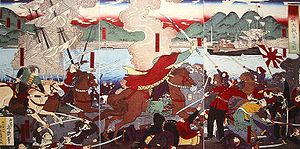Sea Battle of Hakodate

The Battle of Hakodate , May 1869 ; in the foreground the warships Kasuga and Kōtetsu of the Imperial Japanese Navy
| date | May 4, 1869 to May 10, 1869 |
|---|---|
| place | Hakodate Bay , Hokkaido Island , Japan |
| output | Defeat of the Shogunate's Navy, preparation for final defeat |
| Parties to the conflict | |
|---|---|
| Commander | |
| Troop strength | |
| 8 warships | 6 warships |
| losses | |
|
1 ship sunk |
3 ships sunk, |
The naval battle of Hakodate took place from May 4 to May 10, 1869, at the beginning of the Meiji Restoration , in the Bay of Hakodate on the northern Japanese island of Hokkaidō between the Imperial Japanese Navy and naval forces of the Republic of Ezo . The Imperial Japanese Navy won the battle.
prehistory
The remnants of the Tokugawa Shogunate's navy had been taken over partly into the armed forces of the Republic of Ezo and partly into the newly formed Imperial Japanese Navy . The naval forces of the Republic of Ezo were grouped around the warship Kaiten . Initially, the fleet of the Republic of Ezo was superior to the newly founded Imperial Fleet and it was hoped that the dominance at sea would protect the Republic against invasion.
The Ezos fleet originally consisted of eight steamships: Kaiten , Banryū , the gunboat Chiyodagata , Chogei , the frigate Kaiyō Maru and the warship Kanrin Maru , the Mikaho and the Shinsoku . However, the Kaiyō Maru had been lost in a previous confrontation before Esashi and the Kanrin Maru had been taken by the Imperial troops after being badly damaged by a storm.
The fleet of the Imperial Navy was quickly set up for the operation around the ironclad Kōtetsu , built in France and bought by the USA. Other ships in the fleet were the Kasuga , Hiryu , Teibo and the Yoharu .
course
The Imperial Fleet supported the deployment of the Imperial troops on Hokkaido, destroyed coastal fortifications and attacked rebel ships. On May 4th, the Chiyodagata was taken over by the Imperial Navy after it ran aground and was abandoned. On May 7th, the Kaiten was badly hit and incapacitated. The ship of the Republic of Banryo was able to sink the imperial warship Choyo , but later sank because of the heavy damage it suffered. The Imperial Japanese Navy was ultimately victorious. This prepared for the final defeat of the Shogunate's troops at Hakodate.
The present British ship Pearl and the French Coetlogon were neutral in the conflict. The French captain Jules Brunet , who had trained the rebels and supported the defense of the republic, surrendered on June 8 at the Coetlogon .
The future fleet admiral Heihachiro Togo took part in the battle on the emperor's side as a third class officer on board the Kasuga .
literature
- Vice-Admiral George Alexander Ballard, CB: The Influence of the Sea on the Political History of Japan. London: John Murray, 1921. (Eng.)
- Hansgeorg Jentschura, Dieter Jung, Peter Mickel: Warships of the Imperial Japanese Navy, 1869-1945. United States Naval Institute, Annapolis, Maryland, USA; 1977. ISBN 0-87021-893-X . (engl.)
- RVC Bodley: Togo. Life of a hero. Rise of a Nation (1847–1934). Berlin 1936. FA Herbig publishing bookshop.
Individual evidence
- ↑ Jonathan Clements: Admiral Togo: Nelson of the East
